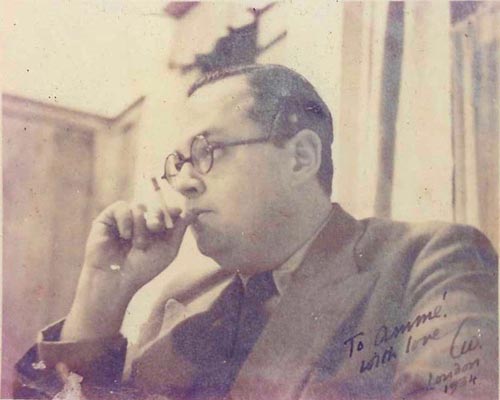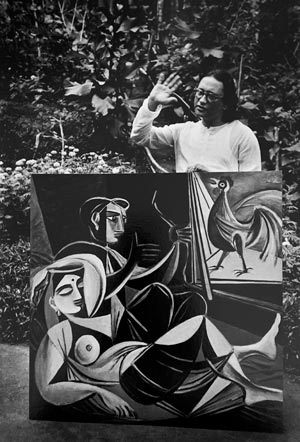Early ties: Lionel Wendt and George Keyt
From what little we know about Lionel Wendt (1900- 1944), there is no doubt that he was a remarkable intellect and worked passionately to achieve mastery of both his chosen interests – music and photography. When developing films in the dark room of his studio, he was inaccessible but when he emerged he was available to his colleagues and fellow artists.

Sent to his ayah: Lionel Wendt: London 1934
Wendt, in fact, was largely responsible for consolidating groups devoted to music, painting and photography. In the crucial years from 1920-1940, his role was principally that of a catalyst stimulating intellectual activities among his artistic colleagues.
His grandfather, who administered Lionel’s interests after the loss of his parents presumed that young Lionel would maintain the family tradition and become a legal luminary. It was implied among family circles that his father’s will stipulated that his son’s studies in England would be financially supported only if he followed a course of studies in law.
But it was music to which he devoted hours.
Lionel’s six years in England (1919 till 1924) were a period of intense engagement in the study of music. It is most likely he combined his interest in music while studying law at Cambridge, and later passing out as a barrister at the Inns of Court, London. But his family’s well laid plans failed to materialize. One abiding mystery was the young Lionel’s neglect of his school career at S. Thomas’ College, Mount Lavinia. He was rebellious at school – a chubby youngster with hardly any interest in sport and studies, his inability to get on with his schoolmates would have resulted in him being teased or bullied.
Growing up, his pursuits of music and photography were unusual. These intellectual pastimes which demanded discipline and long hours of practice could be pressures brought on by his parents, who took an extraordinary interest in his progress.

George Keyt, as photographed by Henri Cartier Bresson in March 1950
His mother discovered his talent for music early in his childhood. By 1911 when he was barely eleven, he was performing to large audiences and it is said, he had a mature stage presence even as a child. By 1919, aged just 18, the piano recital he gave at the Royal College hall featured the works of Bach, Beethoven, Handel, Chopin, Debussy and Liszt, a repertoire one would have expected from a much more mature pianist.
As for photography, his father would often take his son, barely eight to be instructed by the gifted and versatile photographer A.W. Andree at his Hopetown studio in Union Place, a major landmark in Slave Island, Colombo.
And as Andree’s son once observed, “his (Lionel’s) only recreation was a small (Kodak) box camera which my father gave him”. Andree instructed him in the fundamentals of photography, a medium in which he went on to discover new frontiers. The essence of what he explored has now passed into modern practice of photography.
Photography was a family pastime. Lionel’s father Henry Louis Wendt – a senior Supreme Court Judge was an avid student of the new medium and a founder member of Photographic Society of Ceylon in 1906. So was his grandfather John Henricus de Saram who was one of the society’s first presidents. Wendt’s father was in close contact with other practitioners of this new art, and travelled far north to meet the leading photographer in the Jaffna district, Swaminathan Kandiah Lawton.
Lionel Wendt for all his natural gifts was described as a precocious child which did not endear him to his fellow students, and teaching staff of S. Thomas’s College. In the early part of the twentieth century school curricula were based on rote learning and there is no doubt that this mode of traditional schooling may have been an anathema to him.
During the annual school examinations, he submitted terse answer scripts. In a history test paper he wrote a long tract of the opera Trial by Jury by Gilbert and Sullivan – a subject which had little to do with what was expected by his teachers. Many a time his class teacher would take this matter up with the Warden of the College, Rev. W.A. Stone – who was strangely sympathetic to this well-informed scholarly young boy and took little or no action to punish him. As admirers of Bernard Shaw with whose work Lionel was familiar, both Warden Stone and the head teacher Lucien Jansz were kindred spirits
Soon after his 18th birthday, leaving school earlier than expected, Lionel left for England. It was in London and in the years that followed that he could unleash all his boundless energy. He began training at the Royal Academy of Music with the gifted pianist Oscar Berringer and when Berringer died, continued his training under Mark Hambourg.
When he returned home in 1924, he made some feeble attempts to attend the Law Courts in Hulftsdorp but soon gave it all up and turned to his passion – music.
It was in London that Wendt was able to savour a surfeit of exhibitions, lectures and musical performances (ballet and opera) and meet artists and musicians. Brimming with these new radical ideas he returned to Colombo with catalogues of exhibitions (which he likely attended), books and other printed paraphernalia then barely available to his friends in the arts in Colombo.
He took up photography again in the 1930s with a small Rolleiflex camera. For almost a decade he pursued this passion with frantic zeal while still keeping up a rigorous schedule with his music performances in Colombo, playing the classics as well as modern jazz with great ability.
Growing up, his closest friend was George Keyt. They were devoted to each other. They had first met when the Wendt family was holidaying in Kandy; Wendt was 13 and Keyt a few months younger.
It was a lifelong companionship and when the former was in England they kept in touch through a steady stream of letters. Little of this vital correspondence has survived.
Their early lives interestingly seemed to have had the same trajectory. George Keyt’s school record at Trinity College, Kandy was no better than Lionel Wendt’s at S. Thomas’ College.
In 1901 when Keyt was born, Kandy was a small town, with little to offer someone interested in the arts. Trinity College established just half a century before Keyt’s birth was its foremost educational institution. Several members of Keyt’s family including his elder brother attended Trinity but his father Henry Keyt’s (a surveyor by training) laissez-faire approach to George’s education resulted in a late start.
It was rumoured that Keyt when he was ten could neither read nor write and spent most of his time at home. Once when Reverend Fraser, the Trinity College Principal was visiting the Keyt family residence at midday, he observed the boy drawing figures in the sand. Fraser, a close friend of the family enquired from his father Henry why this ten-year-old was not attending school and was taken aback that his father thought it was not important.
The very next day Keyt was enrolled in a class suitable to him, and although initially disadvantaged he picked up as he went along. His reading improved and soon he was wading through difficult prose and poetry including the romantic verse of Algernon Charles Swinburne (1837-1910) popular among the intelligentsia.
Fortuitously the lives of both Wendt and Keyt was to take a turn for the better. Both the Wendt brothers Lionel and Harry would often meet Keyt during their school holidays. The earliest recorded date of their meeting during holiday breaks was ‘from 1913’ when they spent the days with John de Saram, a member of the judicial service like Wendt’s father. This then led to Keyt in turn visiting the Wendt family in Colombo. These visits went on till Wendt travelled to England in 1919.
Born in December 1900, Lionel Wendt was four months senior to George Keyt who was born on April 17, 1901. How much impact such a close friendship had on each other at such an early stage is hard to speculate as very little of these records have survived.
Keyt left Trinity College quite abruptly when he was 16, having paid little or no attention to the instructions of the teaching staff. Much of what he knew was self-taught. On leaving school he decided to work as an assistant in a small photographic studio of Lazarus & Company where he worked as an understudy touching up photo images. Subsequently he is said to have done a stint at the well known photographic studio Plate’s which had its head office in Colombo and branches in Kandy and Nuwara Eliya.
A few months after he left school he became interested in Buddhism and frequented the Malwatte temple in Kandy. His father Henry is recorded to have carried out a considerable amount of surveying work for the Chief Priest at Malwatte and this possibly gave George unhindered access to the activities of the temple. He became attracted to the ritual and practices and was increasingly drawn to the activities of the nascent Buddhist revivalism that was sweeping though the island.
As seen in some of his early work, Keyt was a keen activist and contributed articles, both prose and poetry on the role of Buddhism and also executed several line drawings and water colours illustrating such religious themes.
Those interested in the influence of the friendship and the symbiotic relationship between the two most important personalities of the art scene of twentieth century Sri Lanka, would see how mutually beneficial it was, and crucial to some of the key artistic developments in the island such as the formation of the ’43 Group.
Searching for an ideal partner? Find your soul mate on Hitad.lk, Sri Lanka's favourite marriage proposals page. With Hitad.lk matrimonial advertisements you have access to thousands of ads from potential suitors who are looking for someone just like you.


